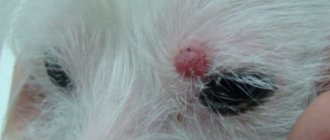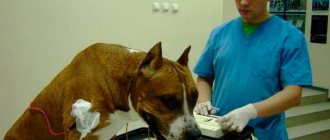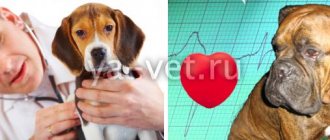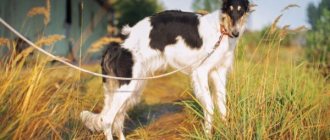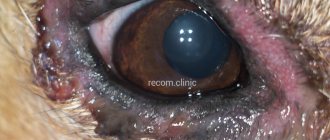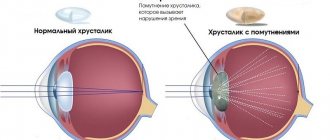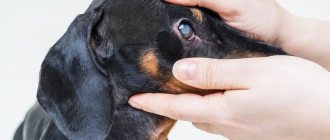The main task of the lymph nodes is to prevent pathogenic microorganisms from entering the dog’s body. While performing this function, they also participate in the redistribution of fluid and produce cells of the immune system. That is why their inflammation requires effective and immediate treatment. Why do lymph nodes become inflamed? What are the symptoms of the disease in a dog? What is the treatment? For more details, see below.
Read in this article:
What is this?
Causes of inflammation of the lymph nodes
Symptoms of the disease: when should you contact a veterinarian?
Diagnostics: basic methods
How is lymphadenitis treated?
What to do at home?
Can complications arise?
Prevention
What is this?
Lymphadenitis (lymphadenopathy) is an inflammatory process affecting the lymph nodes. They perform a filtering function for lymph coming from various internal organs of the pet, and are located next to the blood vessels. That is why their inflammation poses a serious threat to the health and life of the animal.
Forms of lymphadenitis that can be diagnosed in a dog:
- Spicy. All signs of inflammation develop rapidly, and the symptoms are clearly expressed. In 9 out of 10 cases with acute lymphadenitis, the animal experiences a febrile state (increased body temperature).
- Chronic. Its main feature is the “erasure” of symptoms. They do not have the severity characteristic of lymphadenitis and arise gradually. Most often accompanied by pronounced pallor, loss of appetite, and difficulty breathing.
All dog breeds are equally prone to lymphadenitis. However, elderly pets and animals with weakened immune systems are at particular risk. Their health needs to be treated even more carefully in order to prevent dangerous consequences for the entire body.
What is the lymphatic system, the meaning of lymph
The lymphatic system is an integral part of the cardiovascular system of the animal and human body. But! Unlike the circulatory system, lymph circulation is not a vicious circle.
Lymph flows freely and is collected by ducts; this system does not have the shape of a heart; their contents move through the lymphatic vessels very slowly and under extremely low pressure.
Interesting! The main function of lymph is to transport cells of the immune system. In addition, modern scientists believe that the transport function of blood is greatly overestimated, and in fact, most nutrients (especially lipids) are transported by the lymphatic system.
This theory is successfully used in practice by doctors and veterinarians. It turned out that the use of lipophilic drugs sharply increases the rate of their absorption, increases the percentage of drug bioavailability, etc., and the distribution of such drugs throughout the body occurs exclusively with the help of lymph. Today, pharmacists are developing new drugs whose molecules are “implanted” into lipid fragments.
Causes of inflammation of the lymph nodes
Nonspecific inflammation of the lymph nodes develops when various pathogenic microorganisms enter the lymphatic system of the dog's body (for example, bacteria, rickettsia or viruses). In addition, the causes of the disease can be staphylococci, streptococci and E. coli. In this case, the primary source of infection can be ulcers, inflammatory processes of soft tissues, purulent wounds, as well as caries or thrombophlebitis.
In addition to nonspecific lymphadenitis, there is also specific lymphadenitis, which occurs as a complication of a serious illness in an animal (for example, tuberculosis, brucellosis, salmonellosis).
In approximately 5-7% of all visits to a veterinary clinic in Moscow, the development of lymphadenitis in a pet is provoked by other non-inflammatory factors:
- allergies due to frequent contact with an allergen,
- intoxication of the body,
- significant mechanical damage (for example, from a collar that is too tight),
- autoimmune reactions of the dog's body,
- parasitic disease
- reaction after vaccination of an animal, etc.
Disease prevention
Since lymphadenitis is a consequence of other diseases or infections, it is difficult to detect. You need to constantly monitor your pet and check for inflammation. If other symptoms are observed, consult a doctor immediately.
To avoid complications, you need to monitor additional supplements in the diet, as well as give your dog dairy products and take care of proper bowel function. If possible, you can wipe your paws after a walk with antibacterial agents. It is important to monitor the condition of the skin, as well as the general condition of the body.
For the dog, you need to provide proper care, frequent walking, and additionally strengthen the immune system so that in case of infection, the body can overcome it on its own, without additional antibiotics.
Currently reading:
- The American Cocker Spaniel is an adroit hunter and loyal friend.
- Is it worth it or not to include natural food in your dog’s diet?
- Thyroid dysfunction in dogs (hypothyroidism)
- Seven Signs and Remedies for Getting Rid of Fleas in Dogs
Symptoms of the disease: when should you contact a veterinarian?
An attentive and caring owner will be able to quickly detect a disease in their pet (for example, during play). The main sign indicating the development of lymphadenitis is inflammation of the lymph nodes and their pronounced increase in size. At the same time, they become painful, so the dog may react negatively to even light stroking in the area of inflammation.
Please note that lymph nodes are located throughout the animal’s body: behind the ears, behind the jaw, in the groin, at the base of the neck, and also in the armpits of the forelimbs.
Other signs that will help you identify lymphadenitis in your pet:
- Temperature increase.
The dog’s body temperature rises sharply, in especially severe cases it rises to 42 °C. In this case, general weakness, apathy, and chills occur. The animal refuses food and practically does not drink water. Possible sleep disturbances and severe anxiety.
- Rapid breathing.
It becomes more difficult for your pet to breathe. He experiences severe shortness of breath even in the absence of slight physical activity (running, walking, etc.). At the same time, an increase in heart rate (tachycardia) is observed.
- Visual visibility of lymph nodes.
The lymph nodes located behind the dog's jaw and neck are very noticeable. They increase in size and are easily palpable. Pay special attention to this if you have a short-haired dog - the lymph nodes will be very noticeable.
Have you noticed one or more signs of lymphadenitis in your pet? Don’t hesitate - urgently contact a professional veterinarian in Moscow. Self-treatment is unacceptable! Do not risk the health and life of your dog - take it to a veterinary clinic, where your pet will receive qualified care.
Functions of lymph nodes in a dog's body
Lymph nodes are the main structures of the lymphatic system. They perform a number of important functions in the human body and our smaller brothers.
Functions of lymph nodes in a dog’s body:
- Barrier-protective. Lymph nodes are a kind of biological filter in the body. Prevents the spread of pathogenic agents in the body. They retain foreign cells, bodies, foreign bodies entering the lymph and blood.
- Homepoetic. Lymph nodes take part in homepoiesis.
- Filtration. The nodes filter blood flowing to organs and tissues.
- Immune. In the nodes, immunocytes, plasma cells, and protein bodies of globulin nature are formed, which are responsible for the dog’s immunity. T- and B-lymphocytes (cellular structures of humoral, cellular immunity) determine the immune response in case of infection, penetration of viruses and bacteria into the body.
- Reservoir. Lymphatic vessels are a depot for lymph.
Lymph nodes also participate in metabolic processes in the body of animals, carrying out the exchange of proteins, fats, carbohydrates, and vitamins.
Diagnostics: basic methods
Inflammation of the lymph nodes is a very dangerous disease. Taking into account the characteristics of lymph and its movement, the likelihood of infection spreading throughout the pet’s body increases. If you do not respond to the problem in a timely manner and do not seek professional help, then all the internal organs and systems of the pet will be affected by infection.
The main methods used to diagnose lymphadenitis:
- thorough visual inspection of the pet,
- careful palpation of the lymph nodes (in the groin area, under the jaw, etc.),
- laboratory blood test to determine the level of leukocytes and eosinophils,
- taking a puncture from a lymph node to determine the nature of the inflammation.
X-ray and ultrasound methods are widely used in diagnosing the disease. In this case, a biopsy is performed (excision of a piece of tissue for microscopic examination), which allows us to determine the main cause that provoked inflammation in your pet’s body.
Lymph nodes accessible for palpation, their location
In dogs, the following lymph nodes are available for palpation:
- Parotid. It is felt in the area between the temporal bone and the mandibular joint.
- Mandibular nodes. As the name suggests, they should be palpated along the lower surface of the lower jaw.
- Lateral retropharyngeal. Upon palpation, it is found in the same place as the previous one (a non-specialist will still not be able to distinguish them).
- Cervical (superficial) lymph nodes. They need to be felt not on the neck itself, but directly in front of the dog’s shoulder blade.
- Main axillary. It is palpated at the level of the shoulder joint (and often together with the cervical lymph nodes).
- Accessory axillary lymph node. In this case, the chance of finding it is about 40%. It occurs only in every third or even every fourth dog and is located approximately at the level of the articulation of the third or fourth rib with the spine.
It should be taken into account that normally these organs are small, mobile, and are easy to “lose” in the subcutaneous tissue. If the lymph nodes are difficult to detect upon palpation, this is a very good sign. Most likely, the dog does not have hidden infections or inflammations.
How is lymphadenitis treated?
The key to successful treatment of lymphadenitis in a dog is contacting a reliable veterinary clinic. Here they will not only quickly and accurately make a diagnosis, but also prescribe effective therapy. In the treatment of lymphadenitis, an integrated approach is important, so the veterinarian prescribes pharmacological drugs of various spectrums of action.
Firstly, the inflammatory process is suppressed. For these purposes, a course of antibiotics is prescribed, selected by the doctor taking into account the sensitivity of the pathogenic microorganisms that provoked the development of the disease in the dog.
Secondly, hepatoprotectors (drugs intended to maintain liver function) and probiotics are prescribed. They prevent the occurrence of side effects from antibiotics, since their use must be long-term and regular.
Thirdly, a vitamin-mineral complex is prescribed. Typically, special emphasis should be placed on vitamin A (retinol), vitamin B2 (riboflavin) and vitamin C (ascorbic acid). They will help the dog’s body recover much faster from illness.
In cases where inflammation of the lymph nodes is accompanied by a purulent process, surgical treatment is prescribed. It is necessary to open the inflamed area of tissue, and then install drainage (to remove exudate). Subsequently, the rehabilitation period includes regular application of anti-inflammatory ointments and the use of drugs to strengthen the animal’s immune system.
In some cases, your pet may be prescribed physiotherapeutic procedures. For example, heat treatment (ultra-high frequency therapy) helps to quickly reduce the inflammatory response. However, it is important to consider contraindications, the main of which is the detection of malignant neoplasms (oncology).
Treatment of enlarged lymph nodes
Enlarged nodes on the head, neck and armpits are a clear signal to action! Contact your veterinarian immediately! If the reasons are not obvious, in parallel with the examination, the dog is prescribed a biochemical blood test and symptomatic treatment:
- Vitamins and immunostimulants.
- Broad spectrum antibiotics.
- Warming up the inflamed lymph nodes, if the body temperature is not elevated.
- If purulent inflammation is suspected - compresses with Vishnevsky ointment or surgical opening with subsequent installation of drainage.
When using antibiotics, do not forget about the state of the intestinal microflora. Injections for inflammation kill not only pathogens, but also friendly bacteria. Don't wait for indigestion or bloating; introduce probiotics into your dog's diet from the first day of treatment.
It must be clearly understood that the entrained node is not necessarily inflamed. Unfortunately, four-legged animals suffer from incurable diseases and lymphoma (cancer) is one of them. Usually, at an early stage, cancer does not cause discomfort. It manifests itself as a single neoplasm that grows rapidly. The discovery of a “fatal” diagnosis leaves the dog owner with a difficult choice: accept aggressive treatment methods, which, most often, are not effective, or allow the pet to live “as long as it is allotted” and end its life when the time comes.
Inflammation of the lymph nodes in dogs (lymphadenitis) is a disease of the lymph nodes, characterized by an increase in size, pain, and inflammation of the tissue of the lymph nodes. The disease in dogs occurs in acute or chronic form. Let's consider what lymphadenitis is, how the pathology manifests itself, and how to treat your pet at home.
What to do at home?
The first thing to do when you notice signs of lymphadenitis is to contact a veterinarian as soon as possible. This will make it possible to diagnose the disease in a timely manner and prescribe an effective course of therapy or surgical intervention (for example, if the inflammation is accompanied by purulent processes).
The next step is to provide a comfortable environment for the dog. Upon returning from the clinic, do not neglect the doctor's instructions. Give the animal the prescribed medications at a strictly defined time. Make sure that the pet is in a warm and clean place where there are no drafts. Take care of his nutrition, include more vitamins and minerals so that your dog’s strength will be restored even faster.
Forms of lymphadenitis
Lymphadenitis in dogs most often occurs in acute, subacute, and less often in chronic form. It can be specific and non-specific. Specific is a manifestation of a disease. The nonspecific form is not associated with a specific disease. It occurs spontaneously under the influence of negative factors of various natures and, as a rule, against the background of a general decrease in the immune potential and resistance of the body.
Important! Nonspecific lymphadenitis is diagnosed in animals after strepostaphylococcal infection. Lymph nodes may be enlarged or reduced in size.
Based on the nature of inflammation, the following types and forms of lymphadenitis are distinguished:
- Hemorrhagic;
- purulent;
- Fibrous;
- Catarrhal;
- Mixed.
The most severe form of lymphadenitis for dogs is purulent and hemorrhagic.
Depending on the root cause, lymphadenitis can be viral, parasitic, traumatic, autoimmune, or fungal.
Can complications arise?
If you promptly seek help from a veterinarian and treat your dog in accordance with his instructions, you will be able to avoid complications that arise from inflammation of the lymph nodes in animals. If this is not done, the functioning of the entire lymphatic system will be impaired, which means that the pet will lose the natural barrier that protects it from infections.
With nonspecific lymphadenitis, the following complications are possible:
- phlegmon,
- abscess,
- thrombophlebitis,
- sepsis,
- lymphostasis, etc.
The prognosis in the absence of treatment is death.
Symptoms and first signs of inflammation
The intensity of the clinical picture depends on the state of the immune system, age, physiological state, form, and stage of the disease.
Symptoms and first signs of inflammation of the lymph nodes in a dog:
- malaise, general weakness, drowsiness, depression;
- a sharp increase in temperature by 2-3 degrees from the physiological norm (up to 42-42.5 degrees);
- chills, fever, tremor;
- refusal of food, decreased apatite, increased thirst;
- pallor of mucous membranes;
- tachycardia, increased heart rate, change in pulse;
- nausea, vomiting, heavy breathing;
- weight loss;
- difficulty breathing, shortness of breath;
- inadequate response to stimuli;
- reluctant execution of commands, refusal of activities and games;
- deterioration in wool quality;
- allergic reactions, skin rash;
- redness, swelling of the skin in the area of the affected node;
- pain on palpation of an enlarged lymph node.
Important! Lymphadenitis is not always accompanied by acute pain. It all depends on the form and the root cause that caused the inflammatory process.
If the cause of the disease is a malignant tumor, the lymph nodes are not painful, have a dense consistency, and have an uneven, bumpy surface. Lymphosarcoma most often develops in the submandibular and inguinal areas.
Submandibular and cervical nodes may increase in size after preventive immunization. A similar reaction occurs when the immune potential of animals is reduced. If there are no visible post-vaccination complications, there is no need to worry. The dog's condition returns to normal after vaccination on the second or third day.
Prevention
It is best to take care of your dog’s condition in advance and take preventative measures that will help avoid inflammation of the lymph nodes. The most important thing is to treat infectious diseases in a timely manner, since in most cases they provoke the development of lymphadenitis in the animal. Do not self-medicate, seek help from experienced and qualified veterinarians.
Other preventive measures that will help avoid inflammation of the dog’s lymph nodes:
- Never neglect allergic manifestations . It is best to quickly detect the allergen and eliminate it from your pet’s life;
- Take steps to strengthen your dog's immune system. The stronger it is, the more reliably it resists any viruses, parasites and fungi;
- Stick to a balanced diet. Choose food that is suitable for your dog's breed and age.
Remember that your pet needs your attention and care. Unfortunately, he will not be able to say what is bothering him, so it is necessary to be attentive to the health of the animals. Do not neglect regular preventive examinations at the veterinarian and seek qualified help in a timely manner.
Health to you and your pet!
How to detect enlarged lymph nodes
As a rule, by the time the lymph nodes become enlarged, the dog is already experiencing the first symptoms of malaise - weakness, elevated body temperature, poor appetite. The nodes that you can feel have a round or elongated shape and a smooth structure. The examination should begin with the head; you are interested in spherical seals, which can cause a painful reaction in the pet:
- Feel the areas behind the ears and under the curve of the jaw - two pairs of nodes that enlarge first. Don’t be confused, the salivary glands, which have an elongated round shape, are also located under the jaw. Usually, with enlargement of the submandibular lymph nodes, asymmetry is visible on the animal’s face.
- By palpating the tissue on both sides of the larynx, you can detect inflammation of the lymph nodes in the dog’s neck.
- Next, you are interested in the armpits and shoulders of the front legs. Then, we feel the area under the knee on the hind leg.
- We move to the inner thigh. In the armpits of the hind legs, there are inguinal lymph nodes that can be palpated in a “quiet” state. Normally, the nodes should be symmetrical and elongated, and not cause pain when pressed. Inflammation of the dog's lymph nodes in the groin, which is visually noticeable and guaranteed to be accompanied by fever and pain, and sometimes noticeable lameness on the hind legs.
Multiple enlarged lymph nodes may indicate leukosarcoma or leukemia. However, alternate inflammation of the nodes on the way from the hearth to the heart, for example, on the cheek and neck, is an alarming but natural phenomenon. This means that the immune system is already fighting, but the infection is spreading, encountering new “obstacles.”
Note! If the dog does not show any signs of illness, and the nodes are enlarged only on the neck, the cause may be physical pressure - a tightly tightened collar or excessive tension on the leash during walks.
Treatment and prevention
If the owner discovers that something very similar to a lymph node is inflamed in the pet (especially affecting the cervical and axillary regions), then there is no need to try to treat it yourself. Take the animal to a veterinary hospital and have a specialist take blood for analysis. After preliminary diagnosis, the pet may be prescribed a heating pad to the affected area and antibiotic medications.
It is important to understand that lymph nodes should absolutely not be heated if the dog already has an elevated body temperature . In such cases, antibiotics and drugs whose active substances can stimulate the immune system are prescribed. If purulent exudate has collected in the inflamed duct, the treatment regimen includes bandages with Vishnevsky ointment.
Particularly large nodes that interfere with the animal’s movement can be opened during surgery. Drainage is used to drain fluid accumulated inside. After surgery, vitamins will be prescribed. If the body temperature remains elevated after taking antibiotics, the doctor may suspect the oncological nature of the enlarged lymph ducts. In many ways, treatment of lymphosarcoma depends on the stage of the process. This includes hormone therapy and chemotherapy if the animal is able to tolerate it.
Preventive measures should be aimed at preventing the pet from contracting the infection. Get routine vaccinations, take your barking friend to the doctor for checkups, prevent him from hypothermia during the cold season, diversify your dog’s diet with fruits and vegetables. And remember, an increase in the ducts of the lymphatic system is a sure sign that an infection has developed in the pet’s body, which the immune system is no longer able to fight. Ignoring this can lead to the death of your pet.
Sometimes an owner, while playing with his four-legged friend, notices that the pet’s lymph nodes have increased in size. Naturally, every responsible owner has questions: “Why does inflammation of the lymph nodes in a dog’s neck occur, and is it possible to treat at home?”

